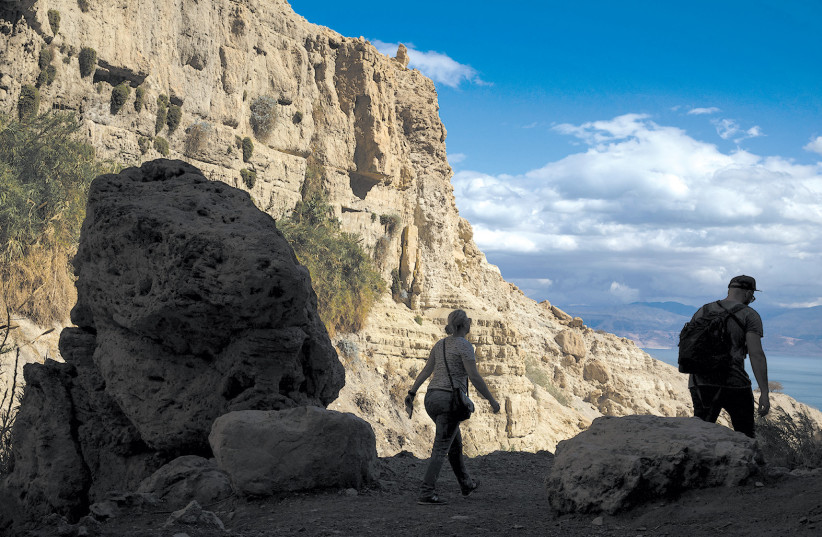I am at the top of another desert mountain.
In Israel, there are many. A look at the map reveals that about half of this country is made up of desert land.
An additional strip from the Sea of Galilee to the Dead Sea looks like desert for much of the year, rocky and full of sand dunes.
There, in the Jordan Valley, a soft layer of green sprouts during the winter months only. This is where we are today.
Today’s particular desert mountain is not the most impressive. It is nothing like Mount Solomon near Eilat, a tall cascade of volcanic stone. It isn’t a flat, tabletop mountain like Mount Tzror in the Negev, nor is it the impossible cliff of Mount Yishai above Ein Gedi.

Today, we are at Sartava, a relatively humble peak. At 377 meters, this precipice still offers impressive views out to the surrounding area’s bare valleys and hills, especially beautiful during March when they become covered in blooming irises.
A chain that held the Jewish people and yearly cycle together in ancient times
Thousands of years ago, when the Temple stood, Sartava formed a link in a chain that held the Jewish people and their yearly cycle together. In a Mishna in the Rosh Hashanah Tractate, one can read through the sections describing the declaration of the new moon. This ceremony, although observed year-round, was particularly relevant on the new year, which was, of course, on the first day of the first month. The Mishna mentions Sartava, the very mountain peak we have climbed today.
The Jewish year follows the lunar cycle. Long ago, before an official Jewish calendar was instituted by Hillel, the new month was calculated by a physical sighting of the new moon, based on the testimony of two witnesses. When the new month was declared, a beacon would be lit on the Mount of Olives in Jerusalem.
At Sartava, many miles away, a second beacon would follow. And so on, the flames formed a chain of light to announce the arrival of the new month to the people of Israel.
Our trip to Sartava began with a drive past Masua, a settlement whose name translates to “torch.” During Elul, when many study the Mishna tractate of Rosh Hashanah, a visit to this nature reserve on top of a desert mountain holds special significance.
On the ascent, we bumped into a flock of sheep, grazing for wild grass on steep cliffs; their fluffy coats seemed somehow out of place in the desert terrain. Tall, white squill flowers grew sporadically along the way, announcing the end of summer. This scene most definitely hearkens back to a time past.
ANOTHER EARLY morning, another desert. On this day, we are on our way to the Judean Desert, past Ma’aleh Adumim . There, we are seeking out another peak with High Holy Day significance, Mount Montar.
According to the Torah, an important part of the Yom Kippur Temple service involved two goats. By lottery, one goat was chosen to be the “seir l’azazel,” the animal that would metaphorically take the nation’s sins upon itself. On the holiest day of the year, one priest would lead the goat out to the desert, miles away from the Temple. There, the seir l’azazel would be thrown from a steep and jagged cliff, its death part of the process of atonement for the people.
Just reading the biblical passages, it’s hard to really conceptualize this unique ceremony. When first learning about the service, I had assumed it took place near the Temple, on some cliff outside of the Old City. I never imagined that sweltering heat or a long trek would be part of the picture. It is for this reason that we are here in this desert – to be able to see the spot for ourselves.
Driving out of the Holy City and into the wilderness beyond, we get a sense of just how long the Yom Kippur journey really was: 14 km. along what is now just a dirt path.
We hike it at sunrise, before the sun has warmed these desert cliffs to an unbearable temperature. No such luxury was given to the priest who took the goat to the edge of the cliff.
Rather, the ceremony took place in the heat of daylight, without the assistance of any sort of vehicle (we drove most of the way from Jerusalem), and while fasting. Along the path from the Temple, people waited with water, like a modern-day water station on a 10K race. According to our sages, no priest ever stopped to drink on the long journey into the desert on Yom Kippur day.
When we arrive at the top of Mount Montar, the sun has just begun to peek above the horizon. It is beautiful here: majestic and stark and dramatic. It’s the perfect place to contemplate the oneness of God and the tininess of our own existence. An apt spot for repentance. We are lucky to have been able to experience it ourselves, and just before the holidays.
It’s no secret that during the months leading up to the new year, Israel’s cities are full of holiday cheer. From sales on apples and honey to echoing shofar blasts, reminders of the season are everywhere. But a trip into Israel’s nature can connect a person to ancient aspects of the holiday celebrations. Atop Sartava and Mount Montar, we experience biblical preparations for the holidays firsthand.
The writer is the creator of Hiking the Holyland (www.hikingintheholyland.com). Her new book, ‘From Southerner to Settler: Unexpected Lessons from the Land of Israel’ is available at www.fromsouthernertosettler.com
